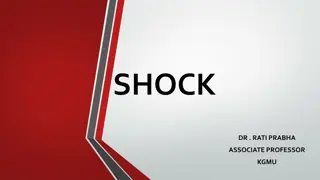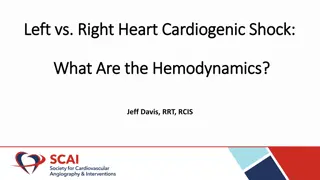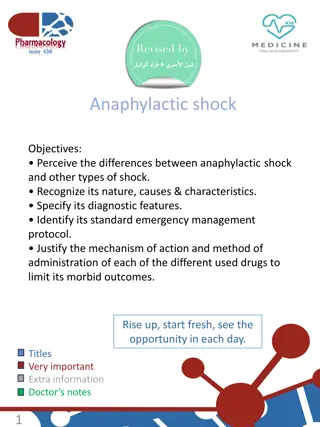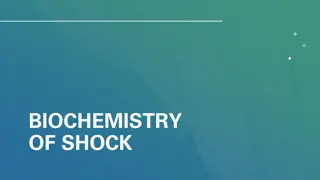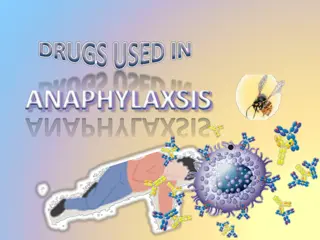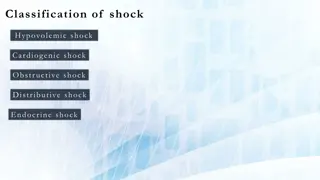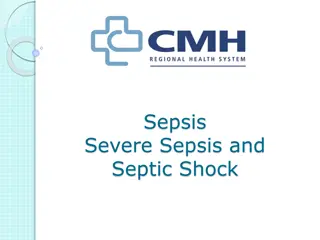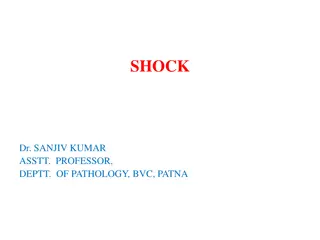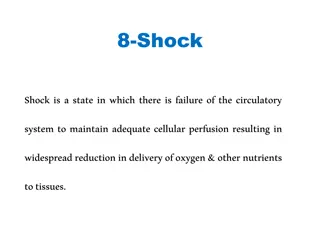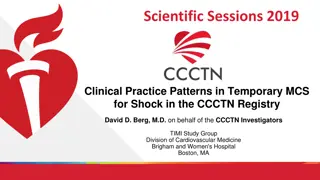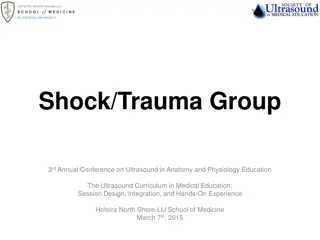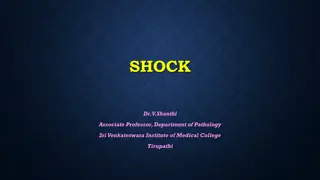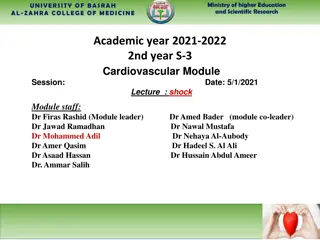Understanding the Physiology of Shock by Professor Narsingh Verma
Shock is a critical condition resulting from poor tissue perfusion and impaired cellular metabolism. Various definitions describe it as inadequate delivery of oxygen and nutrients, leading to reversible or irreversible cellular injury. Different types of shock, such as hypovolemic shock, have common manifestations like low blood pressure, rapid pulse, and cold skin. Causes can range from hemorrhagic trauma to fluid redistribution, with fluid loss playing a crucial role in conditions like hemorrhagic shock. Early recognition of shock symptoms is vital to prevent severe outcomes and mortality.
Download Presentation

Please find below an Image/Link to download the presentation.
The content on the website is provided AS IS for your information and personal use only. It may not be sold, licensed, or shared on other websites without obtaining consent from the author. Download presentation by click this link. If you encounter any issues during the download, it is possible that the publisher has removed the file from their server.
E N D
Presentation Transcript
Physiology of Shock Professor Narsingh Verma
Introduction Shock is a physiologic event with many different causes; but if untreated it has a single clinical outcome Mortality rate - 20%
Different Definitions Shock is a life threatening situation due to poor tissue perfusion with impaired cellular metabolism, manifested in turn by serious pathophysiological abnormalities (Bailey and love) Shock is a term used to describe the clinical syndrome that develops when there is critical impairment of tissue perfusion due to some form of acute circulatory failure. (Davidson s) Shock may be defined as inadequate delivery of oxygen and nutrients to maintain normal tissue and cellular function.(Schwartz s) The state in which profound and widespread reduction of effective tissue perfusion leads first to reversible, and then if prolonged, to irreversible cellular injury. (Kumar and Parrillo ,1995)
Basic Defect Shock verses Circulatory Shock Characterized by Reduction in circulating blood volume and results in inadequate tissue perfusion Hypovolemic Marked expansion of vascular tree Loss of Pumping ability of heart
Early Manifestation Low BP systolic less than 100 mm of Hg Rapid Thready Pulse Tachycardia Cold Clammy Skin Rapid Shallow Breathing Irritability Drowsiness confusion Increased Thirst Oliguria Multiple organ failure
Common Feature Poor tissue perfusion Impaired Oxygenation Impaired Nutrient Supply Decreased removal of Waste Progressive
Hypovolemic Shock SHOCK DUE TO REDUCED BLOOD VOLUME(HYPOVOLEMIC SHOCK OR COLD SHOCK) TRAUMATIC SHOCK HEMORRHAGIC SHOCK SURGICAL SHOCK BURN SHOCK DEHYDRATION SHOCK
Common Causes HEMORRHAGIC : TRAUMA GASTROINTESTINAL BLEEDING NON-HEMORRHAGIC: EXTERNAL FLUID LOSS DIARRHOEA VOMITING POLYUREA FLUID REDISTRIBUTION BURNS ANAPHYLAXIS
Loss of Fluids Fluid Loss Blood water Electrolyte plasma Typical Example Hemorrhagic Shock When loss is more than 15 o 20 % Compensation of the loss Compensatory mechanisms can be short term or long term
Hemorragic Shock Haemorrhage venous return -----Low Stroke Volume ----- Low cardiac output ---Fall in systolic pressure --- fall in pulse pressure --- diminished blood flow to tissues ----Low Po2 High PCO2 and High H ion --- Low blood volume --- Low
Compensatory Mechanisms Shock is prevented by Baroreceptor mechanism BP is mentained Plasma Volume is mentained Low plasma volume ---Fall in systolic pressure -----Fall in capillary hydrostatic pressure ----Filtration > Reabsorption -----Restoration of Plasma Volume Tissue Oxygenation is maintained by local vaso dilation and increase respiration by chemoreceptor reflex Restoration of Blood components by Erythropoiesis, plasma protein synthesis
Treatment of Hypovolemic shock Replacement of Losses as for as possible In place of blood plasma expanders can be used If only plasma and electrolyte are lost blood should not be given Components of blood in place of whole blood Recumbent posture with head end slightly lowered, foot end should be raised slightly
Treatment Contd Room temperature comfortable Breathing a mixture of oxygen and 5% CO2 Pain killer and Tranquilizer may be given but no respiratory depressents Antibiotics Treatment of Specific cause of Shock
Irreversible shock If treatment is delayed NO Response to treatment Loss of Fluid from capillaries : Fluid Continues to be lost Vasodilators to relax the arterioles might help here and corticosteroids which may reduce capillary permeability Hypoxia may induce renal failure which further compromises cardiac functions
Contd Reduction of blood flow to gut Increases intestinal permeability absorption of bacterial toxins, damage to liver --- toxins enter to circulation -----Endotoxic shock or Gram ve shock Reduction in coronary blood flow due to tacchcardia , myocardium is damaged by toxins ------decreased cardiac output Great decrease in BP-- baroreceptors becomes ineffective cerebral ischemic response last effort when vital centers of brain are involved Irreversible shock
Cardiogenic Shock Decrease in cardiac output Decrease in circulating blood volume May be caused by disease of heart coronary blood vessels pericardial effusion
Neurogenic shock Severe pain Profound emotional disturbances Brain damage Widespread vasodilation in capacitance vessels Pooling of Blood in veins Decrease in venous return Decrease in cardiac output
Neurogenic Primarily due to blockade of sympathetic nervous system loss of arterial & venous tone with pooling of blood in the dilated peripheral venous syste The heart does not fill the cardiac output falls Neurogenic shock may be caused by: Paraplegia, Quadriplegia, Trauma to Spinal cord, Spinal anesthesia.
Clinical Features Warm skin, pink & well perfused Heart rate is rapid Blood pressure is low Urine output may be normal
Vaso vagal / Vasogenic Part of neurogenic shock Pathophysiology : pooling of blood due to dilatation of peripheral vascular system particularly in the limb muscle & in splanchnic bed This causes reduced venous return to the heart leading to low cardiac output & bradycardia blood flow to brain is reduced causing cerebral hypoxia & unconsciousness. Management: Trendelenberg position increases cerebral flow & consciousness is restored
Psychogenic Part of Neurogenic shock. Occurs following sudden fright from unexpected bad news or at the sight of horrible accident. Effect may vary in intensity from temporary unconsciousness to even sudden death
Anaphylactic Shock Hypersensitivity reactions can lead to release of histamine and other vasodilatory substances ----increase in capillary permeability ---- Shock
Septic Shock Uncontrolled infection ---release of Bacterial Toxins ----generalized vasodialation and increase in capillary permeability ----shock
Your Questions are also welcome at whats app 9839064560 and narsinghverma@gmil.com


